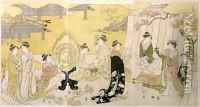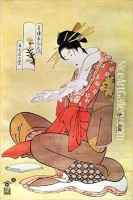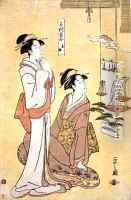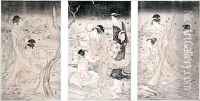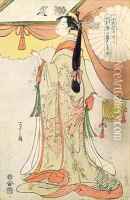Hosoda Eishi Paintings
Hosoda Eishi was a prominent Japanese ukiyo-e artist who lived during the Edo period. Born in 1756 in Edo (modern-day Tokyo), Eishi came from a background of samurai lineage, which was somewhat unusual for an artist of ukiyo-e, a genre of woodblock prints and paintings that typically depicted the 'floating world' of pleasure and entertainment. Eishi began his artistic career after completing his samurai service, initially studying under the Kanō school of painting, which was heavily influenced by Chinese styles and themes.
However, Eishi's career took a significant turn when he became a pupil of Toriyama Sekien, a renowned ukiyo-e artist of the time. Under Sekien's guidance, Eishi shifted his focus to the ukiyo-e style, which was characterized by its depictions of courtesans, kabuki actors, and scenes from daily life among the urban populace. Eishi quickly developed his own distinctive style, which was noted for its grace and elegance. His portrayals of women, in particular, were admired for their beauty and delicacy, and he became known for his bijinga (pictures of beautiful women).
Eishi's works were influential and widely circulated, earning him a significant following and patronage. He often produced multi-panel prints and made use of luxurious materials such as mica and gold leaf to add a sumptuous quality to his images. Despite his success, Eishi eventually left the world of commercial printmaking and returned to painting, focusing on works with classical themes and settings, which were more in line with his samurai background and personal interests.
Throughout his career, Eishi had numerous students who carried on his techniques and stylistic preferences. He continued to paint until his death in 1829. Today, Eishi's artworks are highly regarded in the field of Japanese art, with many of his prints and paintings held in museum collections around the world. They are appreciated not only for their aesthetic qualities but also for their contribution to the development of the ukiyo-e genre.



